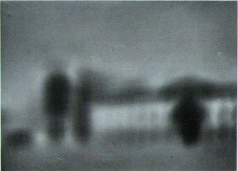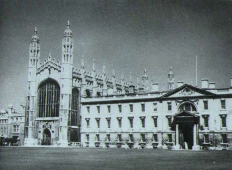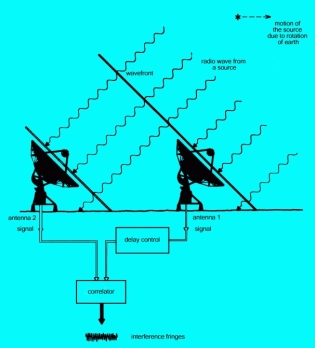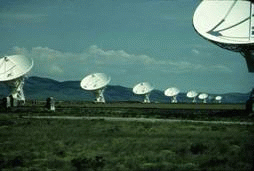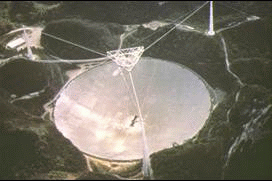Radio astronomy instruments
- The Radio Telescope
A radio telescope is similar to an optical telescope. A large parabolic surface collects the radio waves coming from a source in the sky and concentrates them in a point known as "Focus". Here, a second mirror reflects the beam to a secondary focus that is more easily accessible, where a complex system of "mirrors", receivers and amplifiers transforms it into an electric signal.
|
Important characteristics of a radio telescope:
Sensitivity = capacity to detect weak signals. It increases with the collecting area,
i.e. in proportion to D2 (D = Diameter).
|
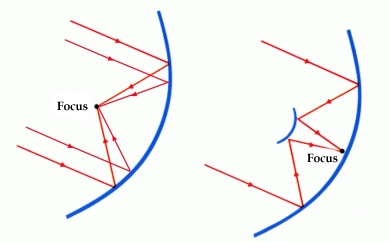 Fig. 1: The electromagnetic radiation |
Radio wavelengths are millions of times longer than optical wavelengths, so we need instruments with extremely large diameters in order to obtain the same resolution as optical telescopes. Let's imagine we have a radio telescope that receives electromagnetic radiations at a wavelength of 20 cm. If it has a diameter D = 30 m, what it would "see" is shown in (a) below. With D = 80 m, the view would be slightly better (photo b). Only with a radio telescope with a diameter D = 1.6 km (photo c) we can obtain the same resolution that we have with the eye.
|
|
|
|
|
Single parabola radio telescopes are a bit short-sighted! |
- The Interferometer
The simplest interferometer consists of 2 dishes (A and B) connected by wires. The radio astronomical signal first reaches dish A, then B, with a delay which depends on the direction in which the antennas are pointing. By introducing a delay into the path of the wave of dish A, we get the signals to arrive in phase to a special computer, called "correlator".
| Fig. 3: The
Very Large Array,
Interferometer, USA. It consists of 27 antennas positioned along 3 arms in
a Y-shape, whose longest extension measures 35 km. |
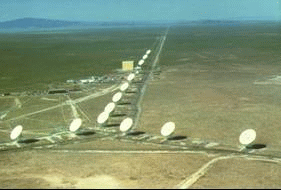 |
|
|
Angular resolution at 20 cm is 1''. |
|
Fig. 4: The
Arecibo Radio Telescope.
A single instrument with a diameter of |
|
- The Very Long-Base Interferometer (VLBI)
The next step, extremely sophisticated from a technologically point of view, is that of interferometers using dishes which are not physically connected. A collection of radio telescopes simultaneously observes the same source. They record the signal on a magnetic support, together with information on time, measured with very precise atomic clocks. The correlator alligns the signals recorded, corrects them according to the various delays and rotation of the earth, and combines them two by two to form the interferometric fringe.The radio telescopes shown in Figure 5 obtain such an enormous resolution that they would manage to distinguish a football ground on the moon!!
|
An eye as big as the earth focused on the cosmos!!!
|
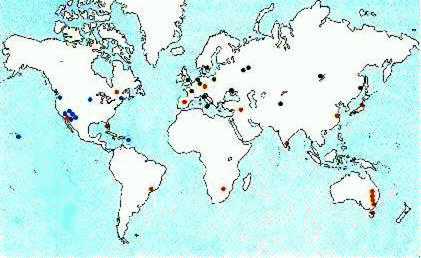 Fig. 5: The dots indicate the position of radio telescopes which can be used for VLBI observations. |
In 1997 the Japanese Space Agency
launched into space an orbiting dish with a diameter of around 10 metres. The dish has recorded interferometric observations using telescopes on
earth, reaching previously unimaginable angular resolution. Hundreds of
extragalactic radio sources have been observed with an angular resolution of
approximately 100 microseconds of arc.
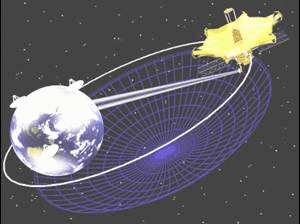 Fig. 6: The Japanese orbiting radio telescope has observed simultaneously with the radio telescopes on earth. |
So it was finally possible to observe the nucleus of galaxies under the microscope!
|
The Webweavers: Last modified Mon, 22 Mar 2004 10:04:51 GMT
